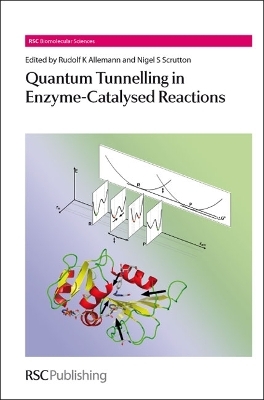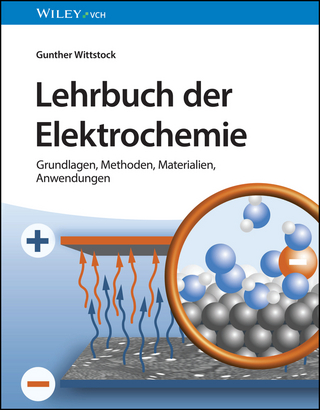
Quantum Tunnelling in Enzyme-Catalysed Reactions
Royal Society of Chemistry (Verlag)
978-0-85404-122-0 (ISBN)
- Titel z.Zt. nicht lieferbar
- Versandkostenfrei innerhalb Deutschlands
- Auch auf Rechnung
- Verfügbarkeit in der Filiale vor Ort prüfen
- Artikel merken
In recent years, there has been an explosion in knowledge and research associated with the field of enzyme catalysis and H-tunneling. Rich in its breath and depth, this introduction to modern theories and methods of study is suitable for experienced researchers those new to the subject. Edited by two leading experts, and bringing together the foremost practitioners in the field, this up-to-date account of a rapidly developing field sits at the interface between biology, chemistry and physics. It covers computational, kinetic and structural analysis of tunnelling and the synergy in combining these methods (with a major focus on H-tunneling reactions in enzyme systems). The book starts with a brief overview of proton and electron transfer history by Nobel Laureate, Rudolph A. Marcus. The reader is then guided through chapters covering almost every aspect of reactions in enzyme catalysis ranging from descriptions of the relevant quantum theory and quantum/classical theoretical methodology to the description of experimental results. The theoretical interpretation of these large systems includes both quantum mechanical and statistical mechanical computations, as well as simple more approximate models. Most of the chapters focus on enzymatic catalysis of hydride, proton and H" transfer, an example of the latter being proton coupled electron transfer. There is also a chapter on electron transfer in proteins. This is timely since the theoretical framework developed fifty years ago for treating electron transfers has now been adapted to H-transfers and electron transfers in proteins. Accessible in style, this book is suitable for a wide audience but will be particularly useful to advanced level undergraduates, postgraduates and early postdoctoral workers.
Nigel S. Scrutton graduated from King's College University of London before obtaining PhD and ScD degrees at the University of Cambridge. He is currently BBSRC Professorial Fellow and Professor of Enzymology at the University of Manchester. He has a longstanding interest in structural and mechanistic enzymology and has made a number of major contributions to the field of H-tunneling in biological systems. He has also been involved in interdisciplinary research programmes addressing the mechanisms of electron and hydrogen transfer in biology. Rudolf K. Allemann obtained a Dipl. Chem from the ETH in Zurich. He then studied for a PhD at Harvard University and the ETH-Zurich where he obtained Dr. sc. Nat. in 1988. He is currently a Research Professor and head of Chemical Biology at Cardiff University. His research interests focus on the physical and chemical basis of enzyme catalysis and structural and synthetic biology. He has also been involved in the de novo design of peptides that catalyze reactions with enzyme-like characteristics. Recently, he has pioneered the development of biophotonic nanoswitches for the control of protein-DNA and protein-protein interactions.
Introduction. Preface: Beyond the Historical Perspective on Hydrogen and Electron Transfers. Chapter 1: The Transition State Theory Description of Enzyme Catalysis for Classically Activated Reactions: Introduction;
Quantifying the Catalytic Activity of Enzymes;
Free Energy Analysis of Enzyme Catalysis;
Transition State Stabilisation or Ground State Destabilisation?;
Selective Stabilisation of Transition Structures by Enzymes;
Enzyme Flexibility and Dynamics. Chapter 2: Introduction to Quantum Behavior - A Primer: Introduction;
Classical Mechanics;
Quantum Mechanics;
Heisenberg Uncertainty Principle;
The Schr÷dinger Equation;
Electronic Structure Calculations;
Born-Oppenheimer Approximation;
Hartree-Fock Theory;
Basis sets;
Zero-point Energy;
Density Functional Theory;
DFT Calculations of Free Energies of Activation of Enzyme Models;
DFT Calculations of Kinetic Isotope Effects;
Quantum Mechanics/Molecular Mechanics Methods;
Summary and Outlook. Chapter 3: Quantum Catalysis in Enzymes: Introduction;
Theory;
Variational Transition State Theory;
The Transmission Coefficient;
One-Dimensional Tunneling;
Multidimensional Tunneling;
Ensemble Averaging;
Examples;
Liver Alcohol Dehydrogenase;
Dihydrofolate Reductase;
Soybean-Lipoxygenase-1 and Methylmalonyl-CoA Mutase;
Other Systems and Perspectives;
Concluding Remarks. Chapter 4: Selected Theoretical Models and Computational Methods for Enzymatic Tunneling: Introduction;
Vibronically Nonadiabatic Reactions: Proton-coupled Electron Transfer;
Theory;
Application to Lipoxygenase;
Predominantly Adiabatic Reactions: Proton and Hydride Transfer;
Theory;
Application to Dihydrofolate Reductase;
Emerging Concepts About Enzyme Catalysis. Chapter 5: Kinetic Isotope Effects from Hybrid Classical and Quantum Path Integral Computations: Introduction;
Theoretical Background;
Path Integral Quantum Transition State Theory;
Centroid Path Integral Simulations;
Kinetic Isotope Effects;
Sequential Centroid Path Integral and Umbrella Sampling (PI/UM);
The PI-FEP/UM Method;Kleinert's Variational Perturbation (KP) Theory;
Potential Energy Surface;
Combined QM/MM Potentials;
The MOVB Potential;
Computational Details;
Illustrative Examples;
Proton Transfer between Viscosity;
Multiple Reactive Configurations and a Place for Single-Molecule Measurements. Chapter 10. Computational Simulations of Tunnelling Reactions in Enzymes;
Introduction;
Molecular Mechanical Methods;
Quantum Mechanical Methods;
Combined Quantum Mechanical/Molecular Mechanical Methods;
Improving Semiempirical QM Calculations;
Calculation of Potential Energy Surfaces and Free Energy Surfaces;
Simulation of the H-tunnelling Event;
Calculation of H-tunnelling Rates and Kinetic Isotope Effects;
Analysing Molecular Dynamics Trajectories;
A Case Study: Aromatic Amine Dehydrogenase (AADH);
Preparation of the System;
Analysis of the H-tunnelling Step in AADH;
Analysis of the Role of Promoting Motions in Driving Tunnelling;Comparison of Short-range Motions in AADH with Long Range Motions in Dihydrofolate Reductase;
Summary. Chapter 11. Tunneling Does Not Contribute Significantly to Enzyme Catalysis, But Studying Temperature Dependence of Isotope Effects is Useful;
Introduction;
Methods;
Simulating Temperature Dependence of KIEs in Enzymes;
Concluding Remarks. Chapter 12: The Use of X-Ray Crystallography to Study Enzymic H-Tunnelling;
Introduction;
X-Ray Crystallography: A Brief Overview;
Accuracy of X-Ray Diffraction Structures;
Dynamic Information from X-Ray Crystallography;
Examples of H-tunnelling Systems Studied by Crystallography;
Crystallographic Studies of AADH Catalytic Mechanism;
Crystallographic Studies of MR;
Conclusions. Chapter 13: The Strengths and Weaknesses of Model Reactions for the Assessment of Tunneling in Enzymic Reactions;
Model Reactions for Biochemical Processes;
Model Reactions Relevant to Enzymic Tunneling;
Isotope Effect Temperature Dependences and the Configurational-Search Framework (CSF) for their Interpretation;
The Traditionally Dependent Category;
The Underdependent Tunneling Category;
The Overdependent Tunneling Category;Example 1. Hydride Transfer in a Thermophilic Alcohol Dehydrogenase;
The Kirby-Walwyn Intramolecular Model Reaction;
The Powell-Bruice Tunneling Model Reaction;
Enzymic Tunneling in Alcohol Dehydrogenases;
Model Reactions and the Catalytic Power of Alcohol Dehydrogenase;
Example 2. Hydrogen-atom Transfer in Methylmalonyl Coenzyme A Mutase (MCM);
Non-enzymic Tunneling in the Finke Model Reactions for MCM;
Enzymic Tunneling in MCM;
Model Reactions and MCM Catalytic Power;
The Roles of Theory in the Comparison of Model and Enzymic Reactions;
Model Reactions, Enzymic Accelerations, and Quantum Tunneling. Chapter 14: Long-Distance Electron Tunneling in Proteins: Introduction;
Electronic Coupling and Tunneling Pathways;
Direct Method;
Avoided Crossing;
Application of Koopmans' Theorem;
Generalized Mulliken-Hush Method;
The Propagator Method;
Protein Pruning;
Tunneling Pathways;
The Method of Tunneling Currents;
General Relations;
Many-Electron Picture;
Calculation of Current Density. Hartree-Fock Approximation;
Interatomic Tunneling Currents;
Many-Electron Aspects;
One Tunneling Orbital (OTO) Approximation and Polarization Effects;
The Limitation of the SCF Description of Many-Electron Tunneling;
Correlation Effects. Polarization Cloud Dynamics. Beyond Hartree-Fock Methods;
Quantum Interference Effects. Quantized Vertices;
Electron Transfer or Hole Transfer? Exchange Effects;
Dynamical Aspects.Chapter 15. Proton-coupled Electron Transfer: The Engine that Drives Radical Transport and Catalysis in Biology;
Introduction;
PCET Model Systems;
Unidirectional PCET Networks;
Bidirectional PCET Networks;
PCET Biocatalysis;
PCET in Enzymes: A Study of Ribonucleotide Reductase;
The PCET Pathway in RNR;
PCET in the ?2 Subunit of RNR;
PCET in ?2 Subunit of RNR: PhotoRNRs;
A Model for PCET in RNR;
Concluding Remarks.
| Reihe/Serie | RSC Biomolecular Sciences ; Volume 17 |
|---|---|
| Verlagsort | Cambridge |
| Sprache | englisch |
| Maße | 156 x 234 mm |
| Gewicht | 752 g |
| Themenwelt | Naturwissenschaften ► Chemie ► Physikalische Chemie |
| ISBN-10 | 0-85404-122-2 / 0854041222 |
| ISBN-13 | 978-0-85404-122-0 / 9780854041220 |
| Zustand | Neuware |
| Informationen gemäß Produktsicherheitsverordnung (GPSR) | |
| Haben Sie eine Frage zum Produkt? |
aus dem Bereich


